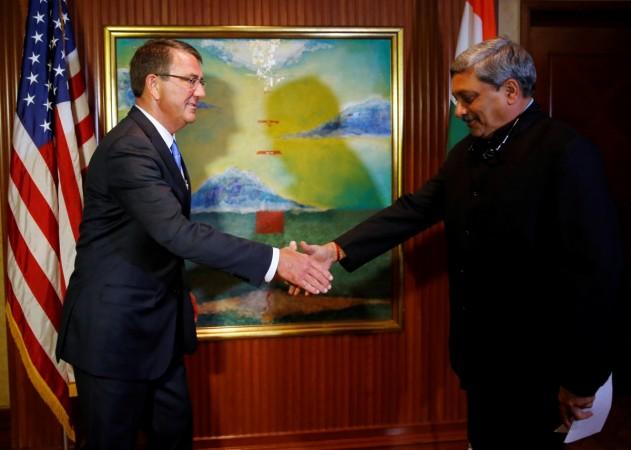
India and the U.S. have signed an important defence pact -- Logistics Exchange Memorandum of Agreement (LEMOA) -- which allows both the countries to access each other's military bases (land, air and naval) for supplies and repairs.
READ : Key highlights of India's historic LEMOA with U.S.
The agreement was signed in the presence of visiting Indian Defence Minister Manohar Parrikar and U.S. Defence Secretary Ash Carter. Parrikar is in the U.S. for a three-day official visit.
LEMOA seeks to facilitate deeper engagement between the two militaries. The agreement boosts India's defence relationship with the U.S. as both seek to counter a growing dominance of the Chinese military.
The agreement makes it easier for both the countries to conduct joint military exercises. Parrikar made it clear that the agreement does not provide for the establishment of bases or any such arrangements and either party is not under any obligation to carry out any sort of joint activities.
Parrikar stressed that logistical support for other cooperative efforts will be on a case to case basis and via prior mutual consent of both the parties. This agreement will support and is expected to be exclusively used in port visits, joint exercise, joint training, humanitarian assistance and disaster relief.
The U.S. considers three agreements – LEMOA, Communication Interoperability and Security Memorandum Agreement (CISMOA) and Basic Exchange and Cooperation Agreement (BECA), a routine with all its defence partners and India is the newest entrant in the league.
This is the sixth meeting between Carter and Parrikar. Carter described Parrikar as "strong and effective leader who is an innovator, great partner and true friend," during the press conference.
India is an important part of the Asia pivot move by the U.S. to counter China's assertive moves in South China Sea. India has been designated as the major defence partner of U.S.
U.S assures support to India's NSG membership
Carter welcomed India's membership to Missile Technology Control Regime (MTCR) and reaffirmed his country's support for India's membership in the Nuclear Suppliers Group (NSG). China has been playing spoilsport in this crucial group for nuclear trade.
Carter and Parrikar welcomed the progress achieved under Defence Technology and Trade Initiative (DTTI) and appreciated the expansion of DTTI's agenda to include five new joint working groups, namely:
- Naval systems
- Air systems
- Intelligence, surveillance and reconnaissance
- Chemical and biological protection
- Other systems
They discussed measures where the U.S. could boost India's capacity for maritime domain awareness (MDA).
Carter recognised India's positive contribution to regional security and stability and also noted the high level exchanges that both the countries are having. Recently, Gen. John Nicholson, the top U.S. commander in Afghanistan, visited New Delhi for consultation on Afghanistan and secretary of the U.S. Navy and the secretary of the U.S. Air Force too visited India.
Both leaders also noted the complex nature of the Yudh Abhyas Army exercises between the two. The next round of exercises will be held in September 2016.
World War II remains repatriation
Carter was appreciative of the support India offered in facilitating the recovering and repatriation of U.S. World War II remains. India reiterated its support and commitment for such missions. It was revealed that a U.S. Defence POW/MIA Accounting Agency (DPAA) would return to India on Nov. 1 to Dec. 14 to survey additional location of air crashes during the World War II.
Parrikar visits 9/11 memorial in Pentagon
Carter and Parrikar laid wreath at 9/11 memorial in Pentagon, Washington D.C.
Carter also offered his condolences for the missing Indian Air Force plane, An-32 with 29 people on board.
Apart from meeting the defence secretary, Parrkar also visited U.S. Cyber Command (CYBERCOM) and met with the leadership of the Defence Innovation Unit Experimental (DIUx).
He is expected to visit Defence Advanced Research Projects Agency (DARPA) and Joint Base Langley-Eustis for a tour of the Air Combat Command (ACC) and the 480th Intelligence, Surveillance and Reconnaissance (ISR) Wing. He will also be interacting with the U.S. defence industry representatives, later during the visit.
Parrikar gets enhanced honour corden welcome
Earlier, Parrikar was welcomed with an enhanced honour cordon at the Pentagon. The honour cordon is reportedly reserved only for valued guests and visitors.
Normal honour cordon entails visitors to be greeted at the Pentagon stairs and welcomed with handshakes, before proceeding to the building. But if the guest is given enhanced honour cordon, then the national anthems of both the nations are played.
Previously, this honour was reserved for Saudi defence minister, China's Central Military Commission vice-chairman Fan Changlong, PM Lee Hsien Loong of Singapore and others.














